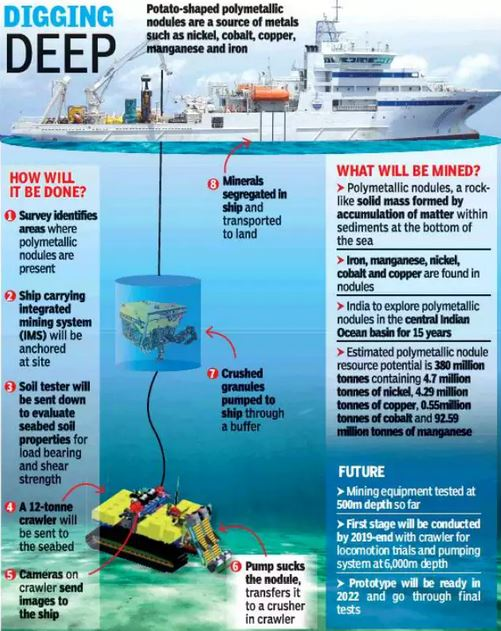Deep Ocean Mission
Why in News:
- The Union Cabinet has approved the Deep Ocean Mission, which among other things involves developing a submersible vehicle that will allow a crew to plunge 6,000 metres into the ocean and hunt the floor for precious metals. It will be a mission mode project to support the Blue Economy Initiatives of the Government of India.
- The technology and expertise for such missions is now available with only five countries – US, Russia, France, Japan and China. India will now be the sixth country to have it.
What are the components of Deep Ocean Mission
- There are six components to the programme.
- A manned submersible will be developed to carry three people to a depth of 6,000 metres in the ocean with a suite of scientific sensors and tools. An Integrated Mining System will be also developed for mining polymetallic nodules at those depths in the central Indian Ocean. The exploration studies of minerals will pave the way for commercial exploitation in the near future, as and when commercial exploitation code is evolved by the International Seabed Authority.
- The second component involves developing Ocean Climate Change Advisory Services, which entails developing a suite of observations and models to understand and provide future projections of important climate variables on seasonal to decadal time scales.
- The third component is searching for deep sea flora and fauna, including microbes, and studying ways to sustainably utilise them.
- The fourth component is to explore and identify potential sources of hydrothermal minerals that are sources of precious metals formed from the earth’s crust along the Indian Ocean mid-oceanic ridges.
- The fifth component involves studying and preparing detailed engineering design for offshore Ocean Thermal Energy Conversion (OTEC) powered desalination plants.
- The sixth component is aimed at grooming experts in the field of ocean biology and engineering. This component aims to translate research into industrial applications and product development through on-site business incubator facilities.
Background of Deep Ocean Mission

- India has been allotted a site of 75,000 square kilometres in the Central Indian Ocean Basin (CIOB) by the UN International SeaBed Authority for exploitation of polymetallic nodules (PMN).
- These are rocks scattered on the seabed containing iron, manganese, nickel and cobalt.
- Being able to lay hands on a fraction of that reserve can meet the energy requirement of India for the next 100 years.
- It has been estimated that 380 million metric tonnes of polymetallic nodules are available at the bottom of the seas in the Central Indian Ocean.
- India’s Exclusive Economic Zone spreads over 2.2 million square kilometres
- The Ministry of Earth Sciences (MoES) will be the nodal Ministry implementing this multi-institutional mission
What is PMN
-
- Polymetallic nodules are rounded accretions of manganese and iron hydroxides that cover vast areas of the seafloor, but are most abundant on abyssal plains at water depths of 4000-6500 metres.
- They form through the aggregation of layers of iron and manganese hydroxides around a central particle (such as a shell or small rock fragment), and range in size from a few millimeters to tens of centimeters.
- Growth of these nodules is extremely slow, at a rate of millimetres per million years, and they remain on the seafloor surface, often partially buried in a thin layer of sediment.
- The composition of nodules varies with their environment of formation, but in addition to manganese and iron, they can contain nickel, copper and cobalt in commercially attractive concentrations as well as traces of other valuable metals such as molybdenum, zirconium and REEs.
- To know more about REE’s(Rare Earth Elements)- https://officerspulse.com/rare-earth-metals/
Other Blue Economy Initiatives related by India:

-
- India-Norway Task Force on Blue Economy for Sustainable Development: in order to promote Sustainable Development, of both the countries. The ultimate goal is to promote sustainable value creation and employment in the ocean-based industries.
- Sagarmala Project: The Sagarmala Programme is an initiative to enhance the performance of the country’s logistics sector. The programme envisages unlocking the potential of waterways and the coastline to minimize infrastructural investments required to meet these targets by using IT enabled services for modernization of ports.
- O-SMART: Main objectives of O-SMART (Ocean Services, Modelling, Applications, Resources and Technology) scheme of Ministry of Earth Sciences (MoES), Govt. of India are
-
- To generate and regularly update information on Marine Living Resources and their relationship with the physical environment in the Indian Exclusive Economic Zone (EEZ),
- To periodically monitor levels of sea water pollutants for health assessment of coastal waters of India, to develop shoreline change maps for assessment of coastal erosion due to natural and anthropogenic activities,
- To develop a wide range of state-of-the art ocean observation systems for acquisition of real-time data from the seas around India,
- To generate and disseminate a suite of user-oriented ocean information, advisories, warnings, data and data products for the benefit of society,
- To develop high resolution models for ocean forecast and reanalysis system,
- To develop algorithms for validation of satellite data for coastal research and to monitor changes in the coastal research,
- Acquisition of Coastal Research Vessels (CRVs) for coastal pollution monitoring, testing of various underwater components and technology demonstration,
- To develop technologies to tap the marine bio resources,
- To develop technologies generating freshwater and energy from ocean,
- Integrated Coastal Zone Management: Integrated coastal zone management (ICZM) or Integrated coastal management (ICM) is a coastal management process for the management of the coast using an integrated approach, regarding all aspects of the coastal zone, including geographical and political boundaries, in an attempt to achieve sustainability.
- National Fisheries Policy: The National Fisheries Policy would offer a strategic way forward to develop, harness, manage and regulate capture and culture fisheries in a responsible and sustainable manner.
Reference:
Subscribe
Login
0 Comments
